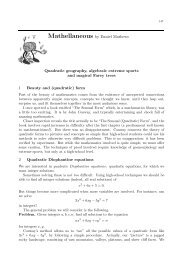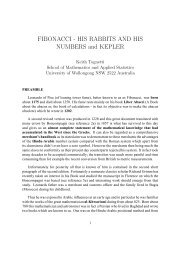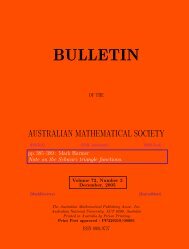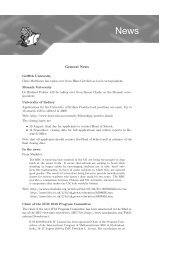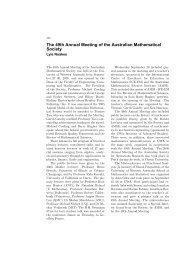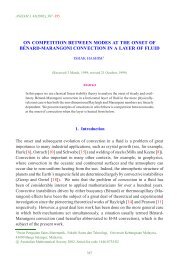Gazette 31 Vol 3 - Australian Mathematical Society
Gazette 31 Vol 3 - Australian Mathematical Society
Gazette 31 Vol 3 - Australian Mathematical Society
Create successful ePaper yourself
Turn your PDF publications into a flip-book with our unique Google optimized e-Paper software.
156 Norman Do<br />
referred to in the modern literature. We will allow any translations and rotations of the animal<br />
and, if asymmetrical, also allow reflections. Once again, a strategy stealing argument<br />
shows that the second player cannot possibly have a winning strategy so to even up the<br />
game, let us decree that the first player wins if they can create the animal, and the second<br />
player wins if they can prevent the first player from doing so. This game was popularized<br />
by Martin Gardner in his column entitled Harary’s generalized ticktacktoe [2], where the<br />
following result appears.<br />
Prove that the first player can win animal tic-tac-toe when the chosen animal is one of<br />
the twelve pictured below.<br />
Winners and Losers<br />
The strategy stealing proof used earlier for N-in-a-row can be translated verbatim to show<br />
that the second player cannot have a winning strategy for animal tic-tac-toe either. This<br />
observation prompted Harary to divide all animals into winners and losers depending on<br />
whether the first player had a winning strategy or not. For example, the problem above<br />
gives a list of twelve winners, including all of those animals of size 1, 2 or 3. The list also<br />
includes all of the animals of size 4, apart from the 2 × 2 square, which is affectionately<br />
known as “fatty”. As we shall see shortly, fatty is a loser which implies that every larger<br />
animal which contains fatty is also a loser. Let us call fatty a “basic loser”, since it is a loser<br />
which does not contain a smaller one.<br />
Theorem: The twelve animals in the figure below are all basic losers.<br />
Proof. Each of these twelve animals can be shown to be losers by providing a pairing strategy<br />
with which the second player can prevent the first from creating the animal. These pairing<br />
strategies are indicated by the five tilings of the plane by dominos below. For example, fatty<br />
is a loser because whenever the first player moves in a square of the second “brickwork”<br />
tiling, the second can retort with a play in the adjacent square belonging to the same





